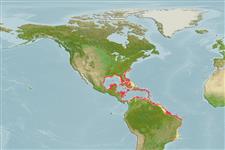Common names from other countries
Teleostei (teleosts) >
Eupercaria/misc (Various families in series Eupercaria) >
Haemulidae (Grunts) > Haemulinae
Etymology: Haemulon: Greek, haimaleos = bloody (Ref. 45335).
More on author: Lacepède.
Environment: milieu / climate zone / depth range / distribution range
Ecology
Marine; reef-associated; depth range 3 - 40 m (Ref. 9626). Subtropical; 39°N - 23°S, 99°W - 30°W
Western Atlantic: Chesapeake Bay, through the Gulf of Mexico and Caribbean southward to Brazil. Including Antilles (Ref. 26938).
Length at first maturity / Size / Weight / Age
Maturity: Lm 18.3, range 11 - 23.23 cm
Max length : 53.0 cm TL male/unsexed; (Ref. 40637); common length : 30.0 cm TL male/unsexed; (Ref. 3798); max. published weight: 4.4 kg (Ref. 4699)
Found in dense aggregations during the day on patch reefs, around coral formations, or on sandy bottoms (Ref. 9710). Juveniles common in Thalassia testudinum beds (Ref. 5217). Feeds on crustaceans, small mollusks, and small fishes. Frequently exhibits a territorial 'kissing' display in which two contenders push each other on the lips with their mouths wide open (Ref. 9710). Marketed fresh. Has been reared in captivity (Ref. 35420).
Oviparous, distinct pairing during breeding (Ref. 205).
Courtenay, W.R. and H.F. Sahlman, 1978. Pomadasyidae. In W. Fischer (ed.) FAO species identification sheets for fishery purposes. Western Central Atlantic (Fishing Area 31), Volume 4. FAO, Rome. (Ref. 3798)
IUCN Red List Status (Ref. 130435)
CITES (Ref. 128078)
Not Evaluated
Threat to humans
Reports of ciguatera poisoning (Ref. 30303)
Human uses
Fisheries: minor commercial; gamefish: yes; aquarium: public aquariums
Tools
Special reports
Download XML
Internet sources
Estimates based on models
Preferred temperature (Ref.
115969): 23.4 - 28, mean 25.9 (based on 342 cells).
Phylogenetic diversity index (Ref.
82804): PD
50 = 0.5000 [Uniqueness, from 0.5 = low to 2.0 = high].
Bayesian length-weight: a=0.01413 (0.01172 - 0.01702), b=2.99 (2.95 - 3.03), in cm Total Length, based on LWR estimates for this species (Ref.
93245).
Trophic level (Ref.
69278): 3.8 ±0.0 se; based on diet studies.
Resilience (Ref.
120179): Medium, minimum population doubling time 1.4 - 4.4 years (K=0.16-0.35; tm=2; tmax=13; Fec=64,000).
Fishing Vulnerability (Ref.
59153): High vulnerability (62 of 100).
